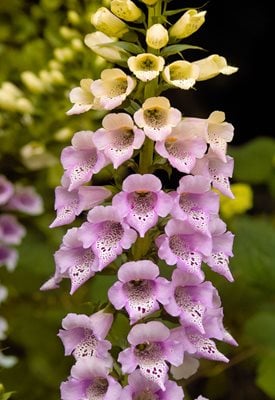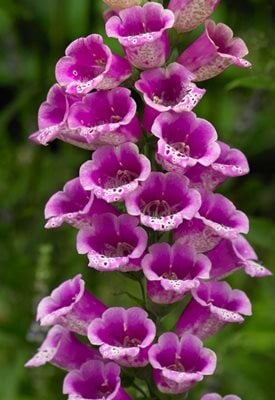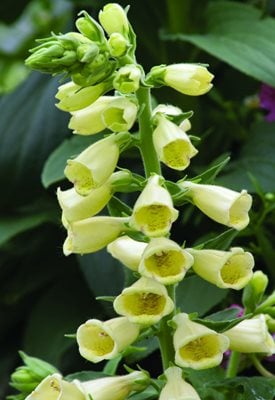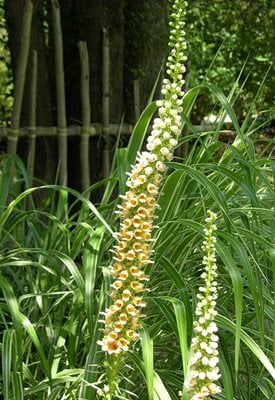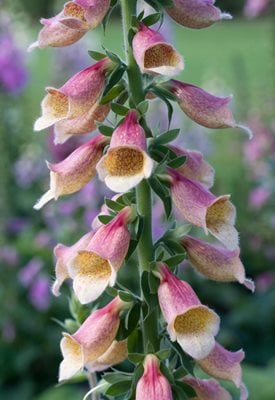Falling in Love with Foxglove
Longer life cycles and extended bloom times are just a few of the reasons to embrace the charms of this old-fashioned favoriteWith nurseries constantly inundated with plants labeled as "new and improved,” it’s easy for gardeners to overlook the classic flowers that have graced gardens for decades. Foxglove is one such plant that seems to have fallen by the wayside as trendier perennials steal their limelight. That’s a shame, because this grande dame of English cottage gardens is far from obsolete. It’s one of the few showy flowers for the shade garden, and there are now more colors and varieties to choose from than ever before. And although most foxgloves are biennials, newer cultivars and hybrids have the staying power of true perennials.
“Many gardeners tend to think of all foxgloves as being strictly two-season wonders. It’s well worth discovering the exceptions because they can be long-lived, truly low-care beauties,” says Larry Hodgson, author of Perennials for Every Purpose.
On this page: The Basics | Grow Your Own | Care Tips | Foxgloves We Love | Plant & Seed Sources
FOXGLOVE BASICS
Botanical name:
Digitalis (from the Latin word digitus, or finger).
Type:
Biennial or perennial,
Zones:
4-8 for most biennial varieties, some perennials are hardy to zone 3.
Height:
1 to 2 feet for dwarf varieties; 3 to 6 feet for others
Flower characteristics:
Both the common and botanical names of foxglove refer to the resemblance of the flowers to the fingers of a snipped-off glove. They grow along the length and sometimes fully encircle tall spikes that taper toward the top like cathedral spires, rising dramatically above low-growing rosettes of dark green foliage. The color palette is primarily soft pastels, often accentuated by darker speckled or veined markings.
Bloom time:
Late spring to midsummer.
Pros:
- Attracts bees and hummingbirds
- Low maintenance
- Deer and rabbit resistant
- Shade tolerant
Cons:
- You might recognize "digitalis" as the name of a heart medicine, which is derived from foxglove and is beneficial in controlled doses. However, all parts of the plant itself are highly toxic if ingested. (See more Common Poisonous Plants for Dogs and Cats.)
- Most biennial foxgloves will not bloom the first year they are planted, but there are some exceptions, such as Digitalis purpurea 'Foxy' and D. purpurea 'Camelot Rose.'
- The flowers are not fragrant.
Common species:
- Digitalis purpurea (common foxglove): The most widely grown species, available in a multitude of cultivars in a broad spectrum of colors, often with attractive spotted throats. Typically a biennial or short-lived perennial. Invasive in some zones/ecosystems (see map). Height: 3 to 4 feet.
- Digitalis grandiflora (yellow foxglove): A beautiful perennial foxglove, with soft lemon-yellow blooms accented by lacy brown veining on the inside. “One the toughest and best-performing members of its clan,” says Hodgson. Height: 2 to 3 feet.
- Digitalis xmertonensis (strawberry foxglove): A hybrid of D. purpurea and D. grandiflora that bears strawberry-pink blooms. Although it’s often considered a short-lived perennial, you can often extend its lifespan by cutting the flower stalks back before they go to seed. Height: 3 to 4 feet.
- Digitalis ferruginea (rusty foxglove): One of the tallest foxgloves, producing spikes of densely packed golden-yellow flowers with brownish-red veining. Height: 4 to 6 feet. (See 12 Flowering Plants for the Summer Garden).
GROW YOUR OWN
Light requirements:
Plant foxglove in a shady to partly sunny location in moist, well-drained soil. The hotter the climate, the more shade your plants will need. Avoid direct afternoon sunlight, which can scorch the leaves.
Soil:
Foxglove thrives in soil that’s high in organic matter and slightly acidic. In alkaline soils, use an organic base soil acidifier to lower the soil pH. See these tips for testing the pH of your soil.
How to plant:
It couldn’t be easier to start foxglove plants from seeds. Because they need light to germinate, simply scatter the seeds on top of the soil and lightly rake them into the surface, leaving them exposed. Keep the soil moist, and once your seedlings emerge thin them to a spacing of 18 to 24 inches to prevent overcrowding.
When to plant:
You can start foxglove seeds indoors in late winter or sow them directly in the garden in spring after the danger of frost has passed. In warmer zones, they can also be started in the fall. The seedlings will emerge in about 2 to 3 weeks, depending on weather conditions. Remember that biennial varieties will not bloom or produce seeds the first year, so you must plant them two years in succession to enjoy new blooms each summer.
Propagating:
Let plants self-seed or sow the seed yourself. Avoid heavy mulching, which will prevent reseeding. To prevent overcrowding, divide clumps of perennial foxglove (not the biennial ones) every few years by separating new plantlets from the crown and replanting at the same depth. If you have a foxglove sprouting up where you don’t want it, simply dig up the root ball and transplant it to another part of the garden. Transplanting and dividing is best done in the cooler weather of spring or fall so your plants won’t suffer from heat stress.
Using in the garden:
Foxglove’s showy spikes of flowers are perfect for creating vertical focal points in cottage gardens, woodland gardens, and other informal plantings.
- In a cottage-style garden, mix foxglove with other shade-tolerant plants of various shapes, colors, and sizes, such as oriental poppy (Papaver orientale), bellflowers, garden phlox (Phlox paniculata), hardy geraniums, bleeding hearts, and astilbes.
- In a woodland garden, combine foxglove with hostas, ferns, and woodland phlox (Phlox divaricata).
- Foxgloves are especially dramatic when massed in groups of five or more plants, especially if you choose a variety that comes in a mixture of colors, such as D. purpurea ‘Foxy’.
CARE TIPS
Watering:
Foxglove is not very drought tolerant, so regular watering is a must during prolonged dry spells, especially for new plants that aren’t yet established. Once your plants become well-rooted, they can tolerate some dryness as long as they aren’t exposed to full sunlight.
Staking:
The flower stalks of foxglove are thick and sturdy and usually require no staking. However taller varieties that grow to heights of 5 feet or more may need some support to prevent them from bending and breaking in the wind and to keep the flower stalks upright.
Pruning:
Many foxgloves will reward you with an encore performance if you remove the central flower stalks after they bloom, which will encourage lateral branching and a second round of blooming. After the second bloom, leave the flower heads in place on biennial plants so they will reseed and continue the two-year cycle. If your plants start to look a bit scruffy toward the end of the growing season, you can improve their appearance while ensuring some reseeding by cutting down most but not all of the flower spikes.
Winter care:
Once your plants have gone to seed, you can remove all the spent flowers and cut back the foliage to just above the crown at ground level. Remove second-year biennial plants that have finished blooming to make room for new plants to grow from seed in the spring. To help retain moisture and protect your plants from frost heave, cover them with a 4- to 5-inch layer of mulch. (See How to Mulch.)
Pest and disease control:
Foxglove is highly resistant to most pests, with the exception of slugs, which love to munch on the leaves. You can pick them off by hand or deter them by sprinkling a commercial slug bait around the plant or creating a simple do-it-yourself trap using a shallow bowl filled with beer. Most of the common diseases that plague foxglove — including leaf spot, powdery mildew and crown rot — are easy to avoid by giving your plant adequate drainage and good air circulation. Also use soaker irrigation rather than overhead watering. Promptly remove any dead or diseased leaves.
FOXGLOVES WE LOVE
RELATED:
Shade Garden Design Ideas
Growing Delphiniums
How to Pick the Perfect Penstemon

